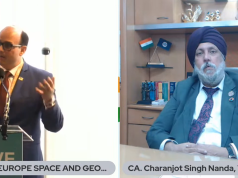There are about 1,400 satellites up in space orbiting Earth monitoring the planet from their vantage point. But the space around Earth is actually crowded with tons of things — from artificial satellites (amateur and serious science missions) to orbital debris. According to NASA, there are more than 500,000 pieces of space junk in the space. The Department of Defense’s US Space Surveillance Network tracks discrete objects as small as 5 cm in diameter in low Earth orbit and about 1 meter in geosynchronous orbit.
Now, Esri has come up with an interesting map that tracks approximately all the satellites orbiting Earth. Satellite Map is a web application developed by Esri‘s Prototype Lab using the beta released of ArcGIS API for JavaScript v4.0. The map was developed by Richie Carmichael, a 13-year veteran at Esri and the Applications Prototype Lab.
The map displays all known man-made satellites, and also includes debris from space collisions and spent booster rockets. The details are interesting. They are color-coded by type and there are buttons and sliders on the left hand side of the application which allow a user to view the details about the satellites — their launch dates, country of origin, purpose and other attributes.


A first click reveals the Earth surrounded by a splash of colored dots. As one starts exploring, an organized pattern emerges amid the apparent chaos — a click on a satellite shows you its path of orbit and 24-hour trajectory shadow.
The 3D view displays approximately 1,400 satelites in low Earth orbit, medium Earth orbit (green dots) and geosynchronous orbit (red dots).
To plot orbiting satellites and paths on a flat, static map would create quite a mess. A virtual globe allows us to plot satellites along with their height for a realistic impression. You can zoom and pan, and watch satellites move around the screen as you move the globe. Click a satellite for specific details, list them, and toggle different types on or off.
Satellite descriptions and ephemeris was sourced from Space-Track. Space-Track.org promotes space flight safety, protection of the space environment and the peaceful use of space worldwide by sharing space situational awareness services and information with U.S. and international satellite owners/operators, academia and other entities. The satellite-js JavaScript library is used to convert a satellite‘s TLE into a geographic location.
Click here to check out the satellite map and have fun!





Comments are closed.